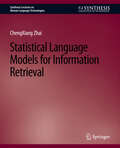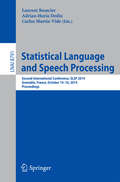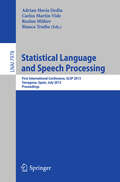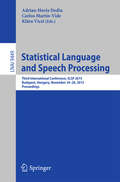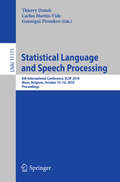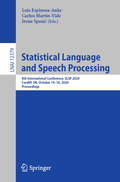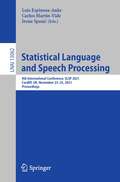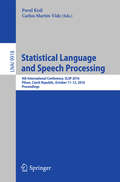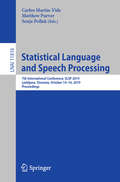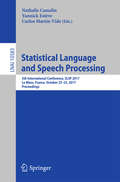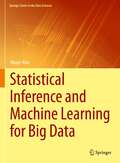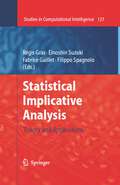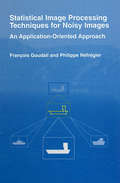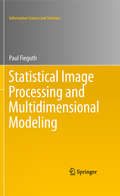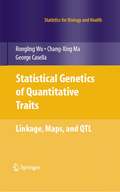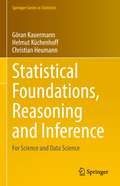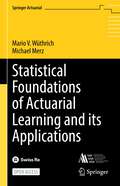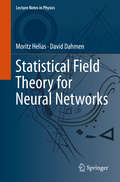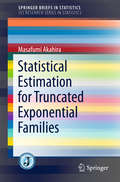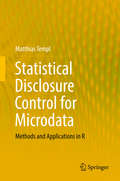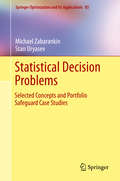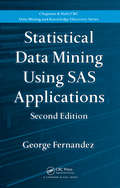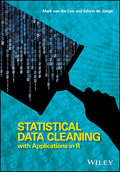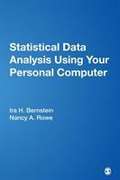- Table View
- List View
Statistical Language Models for Information Retrieval (Synthesis Lectures on Human Language Technologies)
by Chengxiang ZhaiAs online information grows dramatically, search engines such as Google are playing a more and more important role in our lives. Critical to all search engines is the problem of designing an effective retrieval model that can rank documents accurately for a given query. This has been a central research problem in information retrieval for several decades. In the past ten years, a new generation of retrieval models, often referred to as statistical language models, has been successfully applied to solve many different information retrieval problems. Compared with the traditional models such as the vector space model, these new models have a more sound statistical foundation and can leverage statistical estimation to optimize retrieval parameters. They can also be more easily adapted to model non-traditional and complex retrieval problems. Empirically, they tend to achieve comparable or better performance than a traditional model with less effort on parameter tuning. This book systematically reviews the large body of literature on applying statistical language models to information retrieval with an emphasis on the underlying principles, empirically effective language models, and language models developed for non-traditional retrieval tasks. All the relevant literature has been synthesized to make it easy for a reader to digest the research progress achieved so far and see the frontier of research in this area. The book also offers practitioners an informative introduction to a set of practically useful language models that can effectively solve a variety of retrieval problems. No prior knowledge about information retrieval is required, but some basic knowledge about probability and statistics would be useful for fully digesting all the details. Table of Contents: Introduction / Overview of Information Retrieval Models / Simple Query Likelihood Retrieval Model / Complex Query Likelihood Model / Probabilistic Distance Retrieval Model / Language Models for Special Retrieval Tasks / Language Models for Latent Topic Analysis / Conclusions
Statistical Language and Speech Processing: Second International Conference, SLSP 2014, Grenoble, France, October 14-16, 2014, Proceedings (Lecture Notes in Computer Science #8791)
by Laurent Besacier Adrian-Horia Dediu Carlos Martín-VideThis book constitutes the refereed proceedings of the Second International Conference on Statistical Language and Speech Processing, SLSP 2014, held in Grenoble, France, in October 2014. The 18 full papers presented together with three invited talks were carefully reviewed and selected from 53 submissions. The papers are organized in topical sections on machine translation, speech and speaker recognition, machine learning methods, text extraction and categorization, and mining text.
Statistical Language and Speech Processing: First International Conference, SLSP 2013, Tarragona, Spain, July 29-31, 2013, Proceedings (Lecture Notes in Computer Science #7978)
by Adrian Horia Dediu Carlos Martín-Vide Ruslan Mitkov Bianca TrutheThis book constitutes the refereed proceedings of the First International Conference on Statistical Language and Speech Processing, SLSP 2013, held in Tarragona, Spain, in July 2013. The 24 full papers presented together with two invited talks were carefully reviewed and selected from 61 submissions. The papers cover a wide range of topics in the fields of computational language and speech processing and the statistical methods that are currently in use.
Statistical Language and Speech Processing: Third International Conference, SLSP 2015, Budapest, Hungary, November 24-26, 2015, Proceedings (Lecture Notes in Computer Science #9449)
by Adrian-Horia Dediu Carlos Martín-Vide Klára VicsiThis book constitutes the refereed proceedings of the Third International Conference on Statistical Language and Speech Processing, SLSP 2015, held in Budapest, Hungary, in November 2015. The 26 full papers presented together with two invited talks were carefully reviewed and selected from 71 submissions. The papers cover topics such as: anaphora and coreference resolution; authorship identification, plagiarism and spam filtering; computer-aided translation; corpora and language resources; data mining and semantic Web; information extraction; information retrieval; knowledge representation and ontologies; lexicons and dictionaries; machine translation; multimodal technologies; natural language understanding; neural representation of speech and language; opinion mining and sentiment analysis; parsing; part-of-speech tagging; question-answering systems; semantic role labelling; speaker identification and verification; speech and language generation; speech recognition; speech synthesis; speech transcription; spelling correction; spoken dialogue systems; term extraction; text categorisation; text summarisation; and user modeling.
Statistical Language and Speech Processing: 6th International Conference, SLSP 2018, Mons, Belgium, October 15–16, 2018, Proceedings (Lecture Notes in Computer Science #11171)
by Thierry Dutoit Carlos Martín-Vide Gueorgui PironkovThis book constitutes the proceedings of the 6th International Conference on Statistical Language and Speech Processing, SLSP 2018, held in Mons, Belgium, in October 2018. The 15 full papers presented in this volume were carefully reviewed and selected from 40 submissions. They were organized in topical sections named: speech synthesis and spoken language generation; speech recognition and post-processing; natural language processing and understanding; and text processing and analysis.
Statistical Language and Speech Processing: 8th International Conference, SLSP 2020, Cardiff, UK, October 14–16, 2020, Proceedings (Lecture Notes in Computer Science #12379)
by Luis Espinosa-Anke Carlos Martín-Vide Irena SpasićThis book constitutes the proceedings of the 8th International Conference on Statistical Language and Speech Processing, SLSP 2020, held in Cardiff, UK, in October 2020. The 13 full papers presented together with one invited paper in this volume were carefully reviewed and selected from 25 submissions. They papers cover the wide spectrum of statistical methods that are currently in use in computational language or speech processing.
Statistical Language and Speech Processing: 9th International Conference, SLSP 2021, Virtual Event, November 22-26, 2021, Proceedings (Lecture Notes in Computer Science #13062)
by Luis Espinosa-Anke Carlos Martín-Vide Irena SpasićThis book constitutes the proceedings of the 9th International Conference on Statistical Language and Speech Processing, SLSP 2021, held in Cardiff, UK, in November 2021.The 9 full papers presented in this volume were carefully reviewed and selected from 21 submissions. The papers present topics of either theoretical or applied interest discussing the employment of statistical models (including machine learning) within language and speech processing.
Statistical Language and Speech Processing: 4th International Conference, SLSP 2016, Pilsen, Czech Republic, October 11-12, 2016, Proceedings (Lecture Notes in Computer Science #9918)
by Pavel Král Carlos Martín-VideThis book constitutes the refereed proceedings of the 4th International Conference on Statistical Language and Speech Processing, SLSP 2016, held in Pilsen, Czech Republic, in October 2016. The 11 full papers presented together with two invited talks were carefully reviewed and selected from 38 submissions. The papers cover topics such as anaphora and coreference resolution; authorship identification, plagiarism and spam filtering; computer-aided translation; corpora and language resources; data mining and semantic web; information extraction; information retrieval; knowledge representation and ontologies; lexicons and dictionaries; machine translation; multimodal technologies; natural language understanding; neural representation of speech and language; opinion mining and sentiment analysis; parsing; part-of-speech tagging; question and answering systems; semantic role labeling; speaker identification and verification; speech and language generation; speech recognition; speech synthesis; speech transcription; speech correction; spoken dialogue systems; term extraction; text categorization; test summarization; user modeling.
Statistical Language and Speech Processing: 7th International Conference, SLSP 2019, Ljubljana, Slovenia, October 14–16, 2019, Proceedings (Lecture Notes in Computer Science #11816)
by Carlos Martín-Vide Matthew Purver Senja PollakThis book constitutes the proceedings of the 7th International Conference on Statistical Language and Speech Processing, SLSP 2019, held in Ljubljana, Slovenia, in October 2019. The 25 full papers presented together with one invited paper in this volume were carefully reviewed and selected from 48 submissions. They were organized in topical sections named: Dialogue and Spoken Language Understanding; Language Analysis and Generation; Speech Analysis and Synthesis; Speech Recognition; Text Analysis and Classification.
Statistical Language and Speech Processing: 5th International Conference, SLSP 2017, Le Mans, France, October 23–25, 2017, Proceedings (Lecture Notes in Computer Science #10583)
by Nathalie Camelin, Yannick Estève and Carlos Martín-VideThis book constitutes the refereed proceedings of the 5th International Conference on Statistical Language and Speech Processing, SLSP 2017, held in Le Mans, France, in October 2017. The 21 full papers presented were carefully reviewed and selected from 39 submissions. The papers cover topics such as anaphora and conference resolution; authorship identification, plagiarism and spam filtering; computer-aided translation; corpora and language resources; data mining and semanticweb; information extraction; information retrieval; knowledge representation and ontologies; lexicons and dictionaries; machine translation; multimodal technologies; natural language understanding; neural representation of speech and language; opinion mining and sentiment analysis; parsing; part-of-speech tagging; question and answering systems; semantic role labeling; speaker identification and verification; speech and language generation; speech recognition; speech synthesis; speech transcription; speech correction; spoken dialogue systems; term extraction; text categorization; test summarization; user modeling. They are organized in the following sections: language and information extraction; post-processing and applications of automatic transcriptions; speech paralinguistics and synthesis; speech recognition: modeling and resources.
Statistical Inference and Machine Learning for Big Data (Springer Series in the Data Sciences)
by Mayer AlvoThis book presents a variety of advanced statistical methods at a level suitable for advanced undergraduate and graduate students as well as for others interested in familiarizing themselves with these important subjects. It proceeds to illustrate these methods in the context of real-life applications in a variety of areas such as genetics, medicine, and environmental problems. The book begins in Part I by outlining various data types and by indicating how these are normally represented graphically and subsequently analyzed. In Part II, the basic tools in probability and statistics are introduced with special reference to symbolic data analysis. The most useful and relevant results pertinent to this book are retained. In Part III, the focus is on the tools of machine learning whereas in Part IV the computational aspects of BIG DATA are presented. This book would serve as a handy desk reference for statistical methods at the undergraduate and graduate level as well as be useful in courses which aim to provide an overview of modern statistics and its applications.
Statistical Implicative Analysis: Theory and Applications (Studies in Computational Intelligence)
by Régis Gras Einoshin Suzuki Fabrice Guillet Filippo SpagnoloStatistical implicative analysis is a data analysis method created by Régis Gras almost thirty years ago which has a significant impact on a variety of areas ranging from pedagogical and psychological research to data mining. Statistical implicative analysis (SIA) provides a framework for evaluating the strength of implications; such implications are formed through common knowledge acquisition techniques in any learning process, human or artificial. This new concept has developed into a unifying methodology, and has generated a powerful convergence of thought between mathematicians, statisticians, psychologists, specialists in pedagogy and last, but not least, computer scientists specialized in data mining. This volume collects significant research contributions of several rather distinct disciplines that benefit from SIA. Contributions range from psychological and pedagogical research, bioinformatics, knowledge management, and data mining.
Statistical Image Processing Techniques for Noisy Images: An Application-Oriented Approach
by Phillipe Réfrégier François GoudailStatistical Processing Techniques for Noisy Images presents a statistical framework to design algorithms for target detection, tracking, segmentation and classification (identification). Its main goal is to provide the reader with efficient tools for developing algorithms that solve his/her own image processing applications. In particular, such topics as hypothesis test-based detection, fast active contour segmentation and algorithm design for non-conventional imaging systems are comprehensively treated, from theoretical foundations to practical implementations. With a large number of illustrations and practical examples, this book serves as an excellent textbook or reference book for senior or graduate level courses on statistical signal/image processing, as well as a reference for researchers in related fields.
Statistical Image Processing and Multidimensional Modeling (Information Science and Statistics)
by Paul FieguthImages are all around us! The proliferation of low-cost, high-quality imaging devices has led to an explosion in acquired images. When these images are acquired from a microscope, telescope, satellite, or medical imaging device, there is a statistical image processing task: the inference of something—an artery, a road, a DNA marker, an oil spill—from imagery, possibly noisy, blurry, or incomplete. A great many textbooks have been written on image processing. However this book does not so much focus on images, per se, but rather on spatial data sets, with one or more measurements taken over a two or higher dimensional space, and to which standard image-processing algorithms may not apply. There are many important data analysis methods developed in this text for such statistical image problems. Examples abound throughout remote sensing (satellite data mapping, data assimilation, climate-change studies, land use), medical imaging (organ segmentation, anomaly detection), computer vision (image classification, segmentation), and other 2D/3D problems (biological imaging, porous media). The goal, then, of this text is to address methods for solving multidimensional statistical problems. The text strikes a balance between mathematics and theory on the one hand, versus applications and algorithms on the other, by deliberately developing the basic theory (Part I), the mathematical modeling (Part II), and the algorithmic and numerical methods (Part III) of solving a given problem. The particular emphases of the book include inverse problems, multidimensional modeling, random fields, and hierarchical methods.
Statistical Genetics of Quantitative Traits: Linkage, Maps and QTL (Statistics for Biology and Health)
by Rongling Wu Changxing Ma George CasellaThis book introduces the basic concepts and methods that are useful in the statistical analysis and modeling of the DNA-based marker and phenotypic data that arise in agriculture, forestry, experimental biology, and other fields. It concentrates on the linkage analysis of markers, map construction and quantitative trait locus (QTL) mapping, and assumes a background in regression analysis and maximum likelihood approaches. The strength of this book lies in the construction of general models and algorithms for linkage analysis, as well as in QTL mapping in any kind of crossed pedigrees initiated with inbred lines of crops.
Statistical Foundations, Reasoning and Inference: For Science and Data Science (Springer Series in Statistics)
by Göran Kauermann Helmut Küchenhoff Christian HeumannThis textbook provides a comprehensive introduction to statistical principles, concepts and methods that are essential in modern statistics and data science. The topics covered include likelihood-based inference, Bayesian statistics, regression, statistical tests and the quantification of uncertainty. Moreover, the book addresses statistical ideas that are useful in modern data analytics, including bootstrapping, modeling of multivariate distributions, missing data analysis, causality as well as principles of experimental design. The textbook includes sufficient material for a two-semester course and is intended for master’s students in data science, statistics and computer science with a rudimentary grasp of probability theory. It will also be useful for data science practitioners who want to strengthen their statistics skills.
Statistical Foundations of Actuarial Learning and its Applications (Springer Actuarial)
by Mario V. Wüthrich Michael MerzThis open access book discusses the statistical modeling of insurance problems, a process which comprises data collection, data analysis and statistical model building to forecast insured events that may happen in the future. It presents the mathematical foundations behind these fundamental statistical concepts and how they can be applied in daily actuarial practice. Statistical modeling has a wide range of applications, and, depending on the application, the theoretical aspects may be weighted differently: here the main focus is on prediction rather than explanation. Starting with a presentation of state-of-the-art actuarial models, such as generalized linear models, the book then dives into modern machine learning tools such as neural networks and text recognition to improve predictive modeling with complex features. Providing practitioners with detailed guidance on how to apply machine learning methods to real-world data sets, and how to interpret the results without losing sight of the mathematical assumptions on which these methods are based, the book can serve as a modern basis for an actuarial education syllabus.
Statistical Field Theory for Neural Networks (Lecture Notes in Physics #970)
by Moritz Helias David DahmenThis book presents a self-contained introduction to techniques from field theory applied to stochastic and collective dynamics in neuronal networks. These powerful analytical techniques, which are well established in other fields of physics, are the basis of current developments and offer solutions to pressing open problems in theoretical neuroscience and also machine learning. They enable a systematic and quantitative understanding of the dynamics in recurrent and stochastic neuronal networks. This book is intended for physicists, mathematicians, and computer scientists and it is designed for self-study by researchers who want to enter the field or as the main text for a one semester course at advanced undergraduate or graduate level. The theoretical concepts presented in this book are systematically developed from the very beginning, which only requires basic knowledge of analysis and linear algebra.
Statistical Estimation for Truncated Exponential Families (SpringerBriefs in Statistics)
by Masafumi AkahiraThis book presents new findings on nonregular statistical estimation. Unlike other books on this topic, its major emphasis is on helping readers understand the meaning and implications of both regularity and irregularity through a certain family of distributions. In particular, it focuses on a truncated exponential family of distributions with a natural parameter and truncation parameter as a typical nonregular family. This focus includes the (truncated) Pareto distribution, which is widely used in various fields such as finance, physics, hydrology, geology, astronomy, and other disciplines. The family is essential in that it links both regular and nonregular distributions, as it becomes a regular exponential family if the truncation parameter is known. The emphasis is on presenting new results on the maximum likelihood estimation of a natural parameter or truncation parameter if one of them is a nuisance parameter. In order to obtain more information on the truncation, the Bayesian approach is also considered. Further, the application to some useful truncated distributions is discussed. The illustrated clarification of the nonregular structure provides researchers and practitioners with a solid basis for further research and applications.
Statistical Disclosure Control for Microdata: Methods and Applications in R
by Matthias TemplThis book on statistical disclosure control presents the theory, applications and software implementation of the traditional approach to (micro)data anonymization, including data perturbation methods, disclosure risk, data utility, information loss and methods for simulating synthetic data. Introducing readers to the R packages sdcMicro and simPop, the book also features numerous examples and exercises with solutions, as well as case studies with real-world data, accompanied by the underlying R code to allow readers to reproduce all results. The demand for and volume of data from surveys, registers or other sources containing sensible information on persons or enterprises have increased significantly over the last several years. At the same time, privacy protection principles and regulations have imposed restrictions on the access and use of individual data. Proper and secure microdata dissemination calls for the application of statistical disclosure control methods to the data before release. This book is intended for practitioners at statistical agencies and other national and international organizations that deal with confidential data. It will also be interesting for researchers working in statistical disclosure control and the health sciences.
Statistical Decision Problems: Selected Concepts and Portfolio Safeguard Case Studies (Springer Optimization and Its Applications #85)
by Michael Zabarankin Stan UryasevStatistical Decision Problems presents a quick and concise introduction into the theory of risk, deviation and error measures that play a key role in statistical decision problems. It introduces state-of-the-art practical decision making through twenty-one case studies from real-life applications. The case studies cover a broad area of topics and the authors include links with source code and data, a very helpful tool for the reader. In its core, the text demonstrates how to use different factors to formulate statistical decision problems arising in various risk management applications, such as optimal hedging, portfolio optimization, cash flow matching, classification, and more. The presentation is organized into three parts: selected concepts of statistical decision theory, statistical decision problems, and case studies with portfolio safeguard. The text is primarily aimed at practitioners in the areas of risk management, decision making, and statistics. However, the inclusion of a fair bit of mathematical rigor renders this monograph an excellent introduction to the theory of general error, deviation, and risk measures for graduate students. It can be used as supplementary reading for graduate courses including statistical analysis, data mining, stochastic programming, financial engineering, to name a few. The high level of detail may serve useful to applied mathematicians, engineers, and statisticians interested in modeling and managing risk in various applications.
Statistical Data Mining Using SAS Applications
by George FernandezStatistical Data Mining Using SAS Applications, Second Edition describes statistical data mining concepts and demonstrates the features of user-friendly data mining SAS tools. Integrating the statistical and graphical analysis tools available in SAS systems, the book provides complete statistical data mining solutions without writing SAS program co
Statistical Data Cleaning with Applications in R
by Mark van der Loo Edwin de JongeA comprehensive guide to automated statistical data cleaning The production of clean data is a complex and time-consuming process that requires both technical know-how and statistical expertise. Statistical Data Cleaning brings together a wide range of techniques for cleaning textual, numeric or categorical data. This book examines technical data cleaning methods relating to data representation and data structure. A prominent role is given to statistical data validation, data cleaning based on predefined restrictions, and data cleaning strategy. Key features: Focuses on the automation of data cleaning methods, including both theory and applications written in R. Enables the reader to design data cleaning processes for either one-off analytical purposes or for setting up production systems that clean data on a regular basis. Explores statistical techniques for solving issues such as incompleteness, contradictions and outliers, integration of data cleaning components and quality monitoring. Supported by an accompanying website featuring data and R code. This book enables data scientists and statistical analysts working with data to deepen their understanding of data cleaning as well as to upgrade their practical data cleaning skills. It can also be used as material for a course in data cleaning and analyses.
Statistical Data Cleaning with Applications in R
by Mark van der Loo Edwin de JongeA comprehensive guide to automated statistical data cleaning The production of clean data is a complex and time-consuming process that requires both technical know-how and statistical expertise. Statistical Data Cleaning brings together a wide range of techniques for cleaning textual, numeric or categorical data. This book examines technical data cleaning methods relating to data representation and data structure. A prominent role is given to statistical data validation, data cleaning based on predefined restrictions, and data cleaning strategy. Key features: Focuses on the automation of data cleaning methods, including both theory and applications written in R. Enables the reader to design data cleaning processes for either one-off analytical purposes or for setting up production systems that clean data on a regular basis. Explores statistical techniques for solving issues such as incompleteness, contradictions and outliers, integration of data cleaning components and quality monitoring. Supported by an accompanying website featuring data and R code. This book enables data scientists and statistical analysts working with data to deepen their understanding of data cleaning as well as to upgrade their practical data cleaning skills. It can also be used as material for a course in data cleaning and analyses.
Statistical Data Analysis Using Your Personal Computer (PDF)
by Ira H. Bernstein Nancy A. RoweWhat should you see when you are analyzing real data using one of the major statistical packages, such as SPSS, SAS or Microsoft Excel? This book will show you, and will walk you through the output from a variety of statistical outcomes, such as data reflecting a single common factor. Through the use of actual demonstrations, the authors supply readers with the computer programs necessary to simulate data sets with the statistical properties (usually multivariate) that are often assumed of real data. The reader is then shown how to analyze these data sets and how to interpret the results. The book begins with a general introduction to doing research and tips for using the three statistical packages. The authors next explore how to create data structures and perform univariate, bivariate, and multivariate simulations. They then show how to use the simulations to understand common statistical algorithms and their outputs when doing a basic correlation analysis, exploratory factor analysis, confirmatory factor analysis, multidimensional scaling, multiple regression, discriminate analysis, classification analysis and MANOVA. Throughout the book, the authors provide the reader with helpful guides, such as: ·Hint boxes to give readers tips for executing particular techniques using the statistical software packages. ·Steps that show each stage of a procedure, such as importing an Excel file into SAS. ·Problems end each chapter so the reader can practice the techniques described. ·Web Site with the SAS and SPSS programs and sample data.
